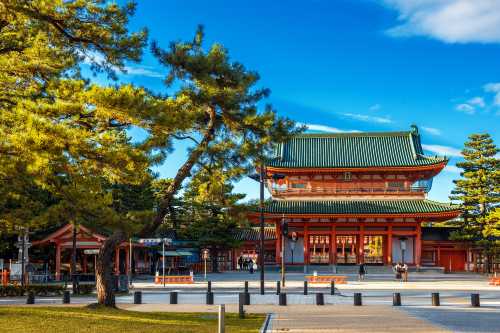Popular Trip Moments
Kiyomizu-dera Temple Kyoto | Walk the Path of a Thousand Torii at Fushimi Inari Taisha | Title: Kyoto: Where Time Rests Among Temples | Kyoto & Nara Highlights One-Day Tour, Hassle-Free Osaka Group Travel Guide | Kiyomizu Temple | แชร์งบเที่ยว 1 Day Trip Kyoto | Tokyo ROKU KYOTO Hotel: The Perfect Experience of Japanese Luxury | Japan In-Depth Travel Guide | 15 Days to Experience the Ultimate Romance of Tradition and Modernity | Philosopher’s Path: A Serene Walk Through Kyoto’s Heart | Kinkaku-ji: Kyoto’s Radiant Golden Temple | Kinkaku-ji: The Golden Pavilion of Kyoto | A Journey Through Fushimi Inari Shrine – Kyoto’s Vermilion Pathway | Fushimi Inari Shrine: Kyoto’s Iconic Path of a Thousand Torii | Arashiyama Bamboo Grove – A Serene Escape in Kyoto | [Kyoto] Let's go see cute mushrooms and world-famous paintings! | [Kyoto] The classic plan! Enjoy Kyoto to the fullest! | [Kyoto] A one-day trip to Arashiyama, enjoying a spectacular train and boat trip | Where Petals Meet Bamboo – A Dreamy Day in Arashiyama | 【Kyoto・Takagamine】 A Hidden Resort Offering Serenity and Hot Springs: Hotel Harvest Kyoto Takagamine | 【Kyoto・Yamashina】 Discover the Hidden Gem of Bishamondo Monzeki Temple | PHILOSOPHER’S PATH | KYOTO’S PEACEFUL CHERRY BLOSSOM TRAIL 🌸🛤️ | Discovering Kyoto: The Timeless Cultural Heart of Japan | Kyoto! A Viral Hotel You'll Love at First Stay – Absolutely Amazing! | Daigo no Hanami: The Stunning Beauty of Weeping Cherry Blossoms | Osaka Transportation Guide|Must-Visit Attractions with the Keihan Railway One-Day Pass | Gleaming Beauty: Experiencing Kinkaku-ji’s Golden Charm | 🌍 Is the Osaka World Expo worth going to? After I went there, I could say: It’s totally worth it! One day is not enough to play❗️ | Kyoto and Osaka Japan Trip! | At Aman Kyoto! Redefining minimalist luxury interpretation | How to get from central Osaka to Nara and Kyoto🌸
Recommended Attractions at Popular Destinations
Bangkok attraction near me | Manila attraction near me | Tokyo attraction near me | Taipei attraction near me | Hong Kong attraction near me | Seoul attraction near me | Kuala Lumpur attraction near me | Los Angeles attraction near me | Shanghai attraction near me | New York attraction near me | Shenzhen attraction near me | Osaka attraction near me | Singapore attraction near me | London attraction near me | Guangzhou attraction near me | San Francisco attraction near me | Beijing attraction near me | Macau attraction near me | Bali attraction near me | Jakarta attraction near me | Paris attraction near me | Ho Chi Minh City attraction near me | Istanbul attraction near me | Phuket attraction near me | Chicago attraction near me | Seattle attraction near me | Toronto attraction near me | Orlando attraction near me | Cebu attraction near me | Chiang Mai attraction near me
Popular Attractions
Jinli Street | Wuhou Shrine | Chengdu Research Base of Giant Panda Breeding | Sunway Lagoon Theme Park | Shanghai Museum | Hangzhou Crazy Apple Land | Spruce Meadow | Waterbom Bali | China Aviation Museum | Hong Kong Disneyland | WILD LIFE Sydney Zoo | Enduring Memories of Hangzhou | A Bamboo-Lined Path Yunqi | Huangpu River | Wuzhen | Well Agro | Dongfengyun Scenic Area | Villa Manaoag Nature Resort and Retreat House | Whale Watch Kaikoura | Lingling Animal Kingdom | Ferme-Auberge de la Ville Andon | Mirador de Tozar | SPORT STADIUM HARDOI | Hazrat Suleman Dargah (Suleman Tekdi) | Swatantra Vir Savarkar Udyan, Swatantra Vir Savarkar Nagar, Dhule road, Chalisgaon, 424101 | Stagno Massarosa | M.Selam Kidanemihret Ethiopian Orthodox Church | Kamarpara Durga Mandir | Baebongsan Neighborhood Park | Baitul Aman Jame Mosque
Popular Restaurants in Kyoto
Gion Maruyama | Gion Matayoshi | Kikunoi Honten | Kyo-Suiran | Nanzenji Junsei | Kinmata | Isshi Souden Nakamura | Kodaiji Wakuden | Kikunoi Roan | Ogata | Honwaka Kyoto Honten | Gion Kawakami | KYOTO GION KOME-RYOTEI HACHIDAIME GIHEY | Tagawa | Tempura Yoshikawa | cenci | Pound Kyoto Ekimae | Uosaburo | Yamamoto Menzou | HANA-Kitcho | Shimogamosaryo | Shunai Sasaki | Kifune Ugenta | Honke Tankuma Honten | Mitsuyasu | Touzan - Hyatt Regency Kyoto | Itoh Dining | Mizuki | Ukihashi | STEAK OTSUKA
Popular Ranked Lists
Top 10 Local Restaurants in Johannesburg | Popular Best Things to Do in Jinchang | Popular Local Restaurants in Dongguan | Top 10 Local Restaurants in Hua Hin | Popular Premium Hotels in Willersey | Popular Best Things to Do in Nan'ao | Popular Premium Hotels in Grodno Region | Top 20 Local Restaurants in Leshan | Top 6 Best Things to Do in Fenghuang | Popular Best Things to Do in Zhuji | Popular Premium Hotels in Chanthaburi | Popular Premium Hotels in Coti-Chiavari | Popular Premium Hotels in Shan | Popular Best Things to Do in Ninghai | Popular Best Things to Do in Lvliang | Popular Premium Hotels in Shodoshima | Top 10 Local Restaurants in Dusseldorf | Popular Best Things to Do in Heze | Top 3 Best Things to Do in Jishou | Popular Premium Hotels in Nishihara | Popular Premium Hotels Near Samosdelka | Popular Premium Hotels in Leognan | Top 4 Best Things to Do in Changji Prefecture | Top 10 Local Restaurants in Naha | Popular Best Things to Do in Danba | Top 19 Local Restaurants in Beihai | Popular Luxury Hotels Near Gizycko County | Top 10 Local Restaurants in Orlando | Popular Premium Hotels Near Makkah Province | Popular Best Things to Do in Long'an
Payment Methods
Our Partners
Copyright © 2025 Trip.com Travel Singapore Pte. Ltd. All rights reserved
Site Operator: Trip.com Travel Singapore Pte. Ltd.
Site Operator: Trip.com Travel Singapore Pte. Ltd.

















